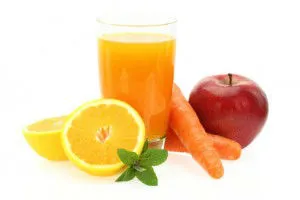You may have heard it said that juicing is good for you – and it is. With few Americans getting the recommended daily amounts of fruits and vegetables, juicing is a convenient way to meet these goals and supply your body with the vitamins and minerals it needs to perform optimally.
FACT: According to the Harvard School of Public Health, the average American gets only three servings of fruits and vegetables per day.
Because it takes quite a few veggies or fruits to make just one ounce of juice, by juicing, you’ll likely get lots more of those nutrient-dense foods. Many people have an aversion to eating produce; juicing provides an easier way to get in the daily required limit. It also allows for consumption of a wider variety of fruits and veggies. As a result, nutritional needs are more likely to be covered.
The Dr. Sears Wellness Institute, and a number of other proponents, also believe that the process of juicing makes the nutrients more readily available for use in the body. The fact that food is already broken down makes it much easier on the digestive system and requires less energy.
The high concentration of nutrients in freshly-squeezed juice super-charges the body with phytonutrients, helping to battle disease and degenerative illness while providing an energy boost. Antioxidants combat the damaging effects of free radicals and can slow the aging process. Other noted benefits of juicing include liver detoxification, improved mental clarity and a reduction in symptoms of depression.
How to Maximize the Benefits of Juicing
Buy Organic: The best products to juice are organic, naturally-grown fruits and vegetables, since they are grown free of pesticides and will provide you with the greatest health benefits.
When you are buying produce, buy only small amounts that you can readily use for juicing or other needs. The best juice is from absolutely fresh produce, so make sure to buy only what you will use within a week.
Prepare Produce: Wash the vegetables thoroughly. Most fruits should be peeled before you put them in the juicer, particularly citrus fruits, the peels of which can leave a bitter taste in the juice. Make sure to keep the white portion of the rind with citrus fruits because it is high in antioxidants.
Cut the produce up into pieces small enough to fit into the feeding tube of the juicer. Make sure to have a container under where the extracted juice will appear. If your juicer automatically ejects unwanted fibers, make sure you have a container ready for this as well.
Get the Right Balance: Overzealous juicing newbies may be tempted to toss in a load of fruits and veggies that are high in natural sugar, or fructose. Most carbohydrates that we eat are made up of chains of glucose that enter the bloodstream and are regulated by insulin. When we consume too much fructose, it floods the liver and the liver cannot process it fast enough for the body to use.
Because of this, the liver turns the excess fructose into fats that become dangerous triglycerides in the bloodstream. So, we may throw in a bunch of carrots, apples, oranges and maybe a few greens thinking that our juice is going to be totally awesome. While it tastes great and gives us a huge burst of energy, this is quickly followed by a case of the “crankies” and lethargy.
We have just taken a fructose roller coaster ride and crashed. To avoid this, it is important to get the right mix of fruits and veggies. Add plenty of greens and just a touch of fruit for flavor.
Use low-sugar veggies like cucumbers and celery to help gain balance. You will still enjoy the fresh and slightly sweet flavor of your juice, and instead of a quick burst of energy, you will feel vibrant and steady for a long time.
Chew Your Juice: To be sure that your body can quickly absorb all of the readily available nutrients in your juice, don’t drink it in a hurry. Although the mouth is used for crushing food, it also secretes saliva which contains the enzyme ptyalin (salivary amylase), which is necessary to initiate the digestion of carbohydrates in the mouth and make them readily available for energy.

If we don’t activate the chewing motion, we are sending the juice to the digestive tract without the very important enzyme necessary for carbohydrate digestion.
Chewing your juice allows the body to figure out how many and what composition of enzymes it needs for digestion. Chewing also matches the temperature of what you are consuming to the temperature inside of your body, so that nutrients are best assimilated and prepared for use.
The other benefit of chewing your juice is that the process alone burns calories. Thats right: chewing actually burns about eleven calories per hour. Take the time to enjoy your juice, savor each sip, swish it around a little and activate the chewing motion, no matter how silly you may feel. Doing this will allow you to maximize its nutritional value and give you more time to enjoy its great flavor and texture.
Enjoy!
-The Alternative Daily
